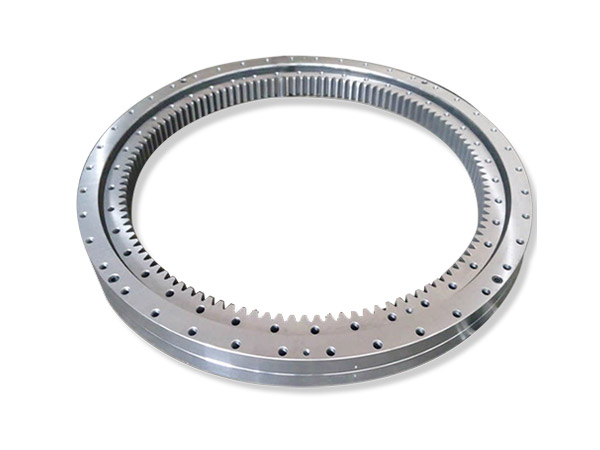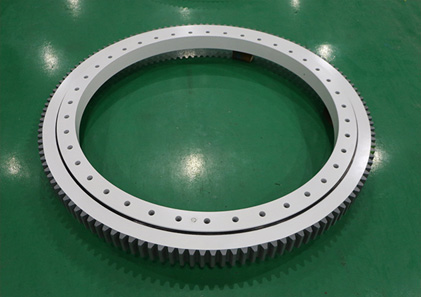How often is the slewing bearing maintained and how to maintain it?
After the slewing bearing is used for a period of time, it is inevitable that there will be problems such as noise, vibration, and temperature rise. In this case, if you want to extend the service life of the bearing, you need to maintain the slewing bearing regularly. Then, how long is the slewing bearing? Maintenance once? What is the maintenance method? What problems should be paid attention to during maintenance? Next, the slewing bearing manufacturer will introduce the maintenance cycle and method of the slewing bearing to everyone, and I hope it will be helpful to everyone.
Slewing bearing maintenance cycle
How often is the slewing ring bearing maintained? The maintenance time of slewing bearings is the same as that of ordinary bearings. Theoretically, they can be used for 20000-80000 hours, but the specific life depends on the wear during use, work intensity and later maintenance, etc., among which maintenance is an important part of prolonging the service life of the bearing. ring.
Maintenance method of slewing bearing

1. Clean the slewing bearing
Cleanliness has a considerable impact on the life of the slewing bearing. The higher the cleanliness of the bearing, the longer the life. Lubricants with different cleanliness have no effect on the life of the bearing. Therefore, improving the cleanliness of the lubricating oil can prolong the life of the bearing. In addition, if the dirt particles in the lubricating oil are controlled below 10um, the life of the bearing will also increase several times. So, how should the specific bearing cleaning be done? We then look down.
(1) The cleaning of the bearing is divided into rough cleaning and fine cleaning, and a metal grid can be placed on the bottom of the container in use.
(2) For rough washing, use a brush to remove grease or adhesions in oil. At this time, if the bearing is rotated in oil, be careful that the rolling surface may be damaged by foreign matter.
(3) During the fine washing, slowly rotate the bearing in oil, which must be carried out carefully. Commonly used cleaning agents are neutral non-water-containing diesel or kerosene, and sometimes warm lye etc. are used as needed. No matter what kind of cleaning agent is used, it must be filtered frequently to keep it clean. After cleaning, immediately apply anti-rust oil or anti-rust grease on the bearing.
2. Derusting bearings
(1) Soaking method: Some small items are immersed in anti-rust grease, and the cross tapered roller bearing is coated with a layer of anti-rust grease on the surface. The thickness of the oil film can be achieved by controlling the temperature or viscosity of the anti-rust grease.
(2) Brushing method: used for outdoor construction equipment or products with special shapes that are not suitable for immersion or spraying. When brushing, it is necessary to pay attention not to accumulate, but also to prevent leakage.
(3) Spray method: Some large anti-rust objects cannot be oiled by immersion method. Bearings are generally sprayed in clean air with filtered compressed air with a pressure of about 0.7Mpa. The spray method is suitable for solvent-diluted anti-rust oil or thin-layer anti-rust oil, but complete fire protection and labor protection measures must be adopted.
3. Bearing lubrication
(1) Manual lubrication: This is a relatively primitive method. When the lubricating oil of the bearing is insufficient, use an oiler to supply oil. However, this method is difficult to maintain a certain amount of oil. It is more dangerous to forget to refuel due to negligence. It is usually only used in light-load, low-speed or intermittent sports. It is recommended to install a dust cap or ball valve on the refueling hole and use it. Felt, cotton, wool, etc. are used as filter devices.
(2) Dropping point lubrication: usually used for light-load and medium-load bearings with a peripheral speed of less than 4~5m/s. A roughly fixed amount of lubricating oil is supplied from the container through holes, needles, valves, etc., the more classic is dripping oil Cup, the amount of dripping oil varies significantly with the viscosity of the lubricating oil, the bearing clearance and the position of the oil supply hole.
(3) Oil ring lubrication: The lubricating oil from the oil pool is brought to the bearing by the ring that is hung on the shaft and can rotate (only for the lubrication method of the horizontal shaft), suitable for medium and high speed shaft diameters greater than 50mm Bearings and oil rings are recommended to be seamless. When the bearing width-to-diameter ratio is less than 2, only one oil ring can be used, otherwise two oil rings are required.
(4) Oil rope lubrication: Relying on the capillary and siphon action of the oil rope to guide the lubricating oil in the oil cup to the bearing, it is mainly used for light-load and medium-load bearings with a peripheral speed of less than 4~5m/s. Can play a filtering role in the whole process.
(5) Oil pad lubrication: Use the capillary action of the oil pad to apply the lubricating oil in the oil pool to the surface of the shaft diameter. This method can keep the friction surface clean, but dust will also block the pores and cause insufficient oil supply. The oil supply of oil pad lubrication is usually only 1/20 of oil lubrication.
Precautions for maintenance of slewing bearings

1. Precautions for cleaning
(1) Qualified new bearings are not cleaned: New bearings that have passed inspections may not be cleaned under normal operating conditions (motors with more than 2 poles); new sealed bearings are not cleaned.
(2) Clean before oil change: The bearing cap and bearing must be cleaned before oil change. The cleaning is divided into rough washing and fine washing. The oil for rough washing is clean diesel or kerosene, and the oil for fine washing is clean gasoline.
(3) Inspection during cleaning: After the bearing is cleaned, turn it by hand and shake it radially and axially by hand to determine whether it is loose or the gap is too large. Check the gap if necessary. If the ball or roller frame is found to be severely worn, rusted, and metal peeling, it should be replaced.
(4) Wipe dry and grease after cleaning: After the bearing is cleaned and inspected, wipe the cleaning agent (or dry) with a white cloth, and add qualified grease. It is not allowed to add different types of grease in the same bearing.
2. Precautions for rust removal
(1) Selection of derusting liquid: Note that the following acid liquids cannot be used for bearing derusting: sulfuric acid, hydrochloric acid, dilute sulfuric acid, and dilute hydrochloric acid. Because these acid liquids will destroy the good metal parts, these kinds of liquids cannot be used!
(2) Selection of rust removal methods: I have introduced several common rust removal methods above, including soaking method, brushing method, spraying method, etc. You can choose according to the actual situation of the bearing, but no matter which method it is It is necessary to pay attention to the protection of the bearing during operation. The damage to the bearing due to maintenance is more than the loss.
3. Precautions for lubrication
(1) No dust in the surrounding environment when refueling: refuel with clean hands, slowly rotate the entire bearing with one hand, and press the oil into the bearing gap with the middle finger and index finger of the other hand. After adding one side, proceed to the other side to remove excess grease.
(2) Bearing and bearing cap refueling volume: The bearing cap oil volume is 1/2-2/3 of the bearing cap capacity (the highest number of poles of the motor is the upper limit); the bearing oil volume is 1/2-2/3 of the cavity of the inner and outer rings of the bearing ( The number of motor poles is higher than the upper limit).
The above is about how often the slewing bearing is maintained, the maintenance cycle and the entire content of the method. We understand that the general slewing bearing is maintained every 20000-80000 hours. The specific time needs to be determined according to the actual situation. The maintenance method includes regular cleaning, which is effective. Rust, reasonable lubrication, etc. It can be seen that if you want to extend the service life of the slewing bearing, you still need to work harder and maintain it.

